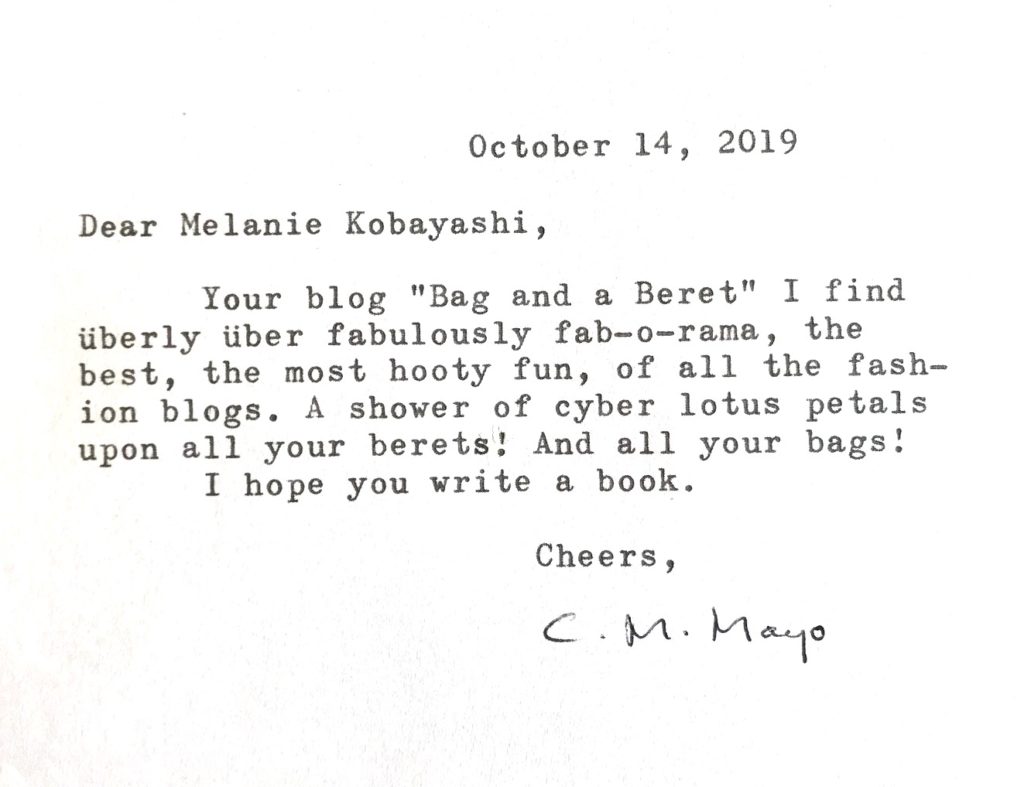
This blog posts on Mondays. Second Mondays of the month I devote to my writing workshop students and anyone else interested in creative writing. Welcome!
> For the archive of workshop posts click here.

As a literary writer with a fashion sense I might describe as Jesuitical-but-with-colorful-scarves (and that will do for me, thank you very much, re: possibilities #10 and #11), what am I doing reading, never mind blogging about a fashion blog?
As I stress in my creative writing workshops, it has been my consistent experience that to stay limber and working fluidly I need to regularly read outside my comfort zone. And I mean, read outside my comfort zone as a writer, pencil in-hand.
(Is this practice right for you as a creative writer? Well, I don’t know your innermost inner artist, nonetheless, I’d bet my three typewriters that he or she would find it bongo-drums + a B12 shot for creative energy. And I’d bet my laptop, too.)
Reading as a writer, as I detailed in this previous blog post, and this entire blog about War & Peace, is a fundamentally different endeavor than reading to pass the time, or, say, reading something just because all your friends and the people you presume to impress have read it, or reading because your book club picked it, or for some scholarly purpose, or whatever combination thereof.
Reading as a writer is reading to identify what precisely works here? What precisely is ineffective? And precisely why this effective, or that ineffective?
In short, there are rafts of techniques and I consider it essential to be able to identify them when they are used to effect– or could have been.
On other words, if a piece of writing sings to you, it is in no way helpful to you as a writer to get all awesomed out, saying things like, golly wow, no wonder he won the Nobel Prize, little ol’ me, why, I could never do that!
Well, ick. Stoppit. You can do this.
You need to ask, precisely why do I find this bit good? How, precisely, did the writer achieve this effect? What specifically can I learn here?
Ditto, if you find a piece of writing bad. Why is it bad? What specifically can I learn from this?
Reading as a writer, pencil in hand, I’ll read in my comfort zone– writers such as Willa Cather, Tolstoy, Edith Wharton, et al. But for creative inspiration I’ll also take a more than occasional jog outside my comfort zone: a spree on books about UFOs, gun mags, a guide to caring for your iguana (I do not have an iguana, I never had an iguana and I do not care to have an iguana, but anyway now I know a lot about iguanas), and (this comes with the territory of writing about Far West Texas) self-published cowboy memoirs.
Add to that ever-expanding list–this week only!–fashion blogs.
(What’s outside your comfort zone, dear writerly reader?)
OK, yes, a lot of the writing in these out-of-my-comfort-zone genres tends to be, shall we say, pedestrian. I cannot say anything in the how-to-care- for-iguanas genre, to take one example, would merit quoting for its lyrical qualities… but I may well have a character in my next novel who knows a heap about iguanas, and his green monster, Peps, who likes to hide his stash of flies under the sofa…
But sometimes I am surprised. I am always open to being surprised!
Fashion bloggers… There’s a heap to say about those fashion bloggers… but describing that colorful subculture and its effervescent personalities is not my purpose here. What I want to spotlight in this month’s workshop post is the vervy-good writing in Vancouver Canada-based artist Melanie Kobayashi’s fashion blog, Bag and a Beret.
To wit:
Sometimes I am giddy with the idea of throwing everything out, O-U-T, out! No more clutter, clenched sphincters, and squinty eyes. Instead, a confounding profound serenity. Like the scent of jeans fresh from the freezer. Clouds would be fluffier. Doritos would be healthier. I’d take up yoga, do downward dogs and sideways cows, and start saying all those namasty things. And drink green fluids with stringy bits.
—Is That An Alien in My Closet?
Melanie Kobayashi, Bag and a Beret, March 4, 2016
Because this is a workshop post, I’m going to get all workshoppy now and pick this apart. Which kills the fizz in it, I know, but the purpose here is to identify some of the poetic techniques Kobayashi uses that might well serve you for your writing.
Actually there is a whole bouquet of literary techniques in Kobayashi’s paragraph. To point out just four of the techniques:
(1) She varies her syntax– such delicious, jiggy energy! Note her short, punchy sentences: Clouds would be fluffier. Doritos would be healthier... And drink green fluids with stringy bits.
> See my post on Virginia Tufte’s Artful Sentences: Syntax as Style
(2) Like the finest of poets Kobayashi gives us specific detail that appeals to the senses: Texture (fluffier clouds); temperatures (“jeans fresh from the freezer”); tastes (Doritos, “green fluids with stringy bits”)
> See my post on Techniques of Fiction: The Number One Technique in the Supersonic Overview
(3) Kobayashi indulges in wild fancies (“Doritos would be healthier”; “sideways cows”)
> Try some permutations, e.g., Big Macs would be healthier; sideways alpacas… ??? Go for it!
(4) Brilliant use of a diction drop (“namasty things”)
> See my post on Diction Drops and Spikes
#
Another example of vervy-good writing from Melanie Kobayashi’s blog:
Alert, another face pose! This aluminum-foilesque blazer is exactly my style. I adore the humongous acrylic buttons. Shelley grabbed it for a try-on on our way out. The way I farked this photo reminds me of a popular Canadian TV ad where a couple heats their home so hot that it melts cheese. In this case, I would be the potato.
—Friends Galore and Imaginations Gone Wild,
Melanie Kobayashi, Bag and a Beret, June 29, 2019
And:
Today I feature alluuuuring, not-quite-lurid, languid bedroom attire as corporate pyjama daywear, or, as I shall call it, Bed to Boardroom. “Oh James, bring me the latest numbers so I can calculate how bad I am at math. On second thought, skip the math and let’s go straight to drama, English literature. Bring me another martini and wheel in the divan.”
—Corporate Pyjama Daywear, Leopard-Style
Melanie Kobayashi, Bag and a Beret, October 21, 2017
There’s a lot of music in this quote:
(1) stretching and playing with words, e.g., “alluuuuring”
Hoosezayakant!
(2) Alliteration: “Bed to Boardroom”
> See my post on Poetic Alliteration
(3) Voices (the quote “Oh James…”)
Bringing in other voices adds to musicality. (There will be a blog post on this topic…)
(4) Commands (“bring me…”)
Commands, like questions, also add to musicality. (There will be a blog post…)
(5) Repetition (“bring me… bring me…”)
> See my post on Poetic Repetition
#
Yet another example from Kobayashi’s Bag and a Beret:
So I wore this vintage barkcloth maxi the other day. You may have seen it before – but not with my lovely lava pendant paired with that other one, looking very, dare I say, fly? And bracelets. I don’t wear them often because my wrists are small and the bangles clamp my hands when they dangle down. So here we have a Hawaiian-made dress with lava jewels and hiking boots (with fringe and platforms, an improvement on the standard fare). Do I sense a pattern here? Why, of course – I should be a vulcanologist! It’s so clear now. Open your mind. Let your clothes guide you!!
—Let Your Clothes Choose Your Profession
Melanie Kobayashi, Bag and a Beret, July 1, 2015
Just a few of many things I could note in this are her use of alliteration; questions; and splendid use of specific sensory detail (e.g., “And bracelets. I don’t wear them often because my wrists are small and the bangles clamp my hands when they dangle down.”)
#
More!!
This is a project-ish project– paring down my clothing and focusing more on earrings and suchlike, meaning tights, hair thingies, face paint, maybe shoes. I am looking forward to the challenge but this is mainly an attempt to free up more space in my space-challenger home. In fact, I bought some Ziploc Space Bags (in tropical colours), which are vacuum-resealable bags capable of squishing a huge pile of clothing into one fruity brick. Spacey, baby, spacey.
—Why Do Laundry When You Have Scissors?
Melanie Kobayashi, Bag and a Beret, February 17, 2014
Expert use of poetic repetition!
Dig that “fruity brick”!
> See my post on Using Imagery (“The Metaphor Stuff”)
#

P.S. Check out Melanie Kobayashi’s video, The Leather Pants 2.
And check out my workshop page for oodles more resources for writers.

Grokking Plot: The Elegant Example of Bread and Jam for Frances
Notes on Tom Lea and His Epic Masterpiece
of a Western, The Wonderful Country
“Silence” and “Poem” on the 1967 Hermes 3000
Find out more about C.M. Mayo’s books, shorter works, podcasts, and more at www.cmmayo.com.





